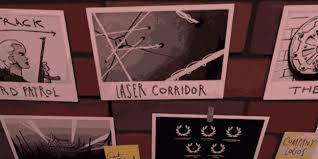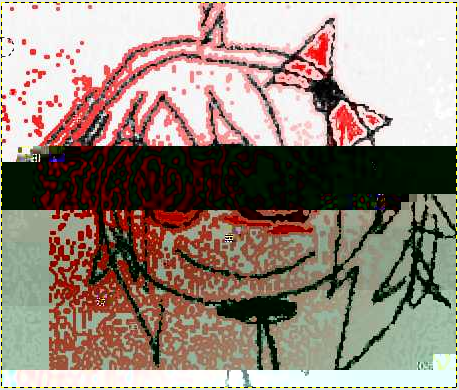For this analysis I’ll be looking at three similar games that are both good and bad for their own reasons. Disregarding popularity as a selling point and explaining what they do and why. I’ll be looking at three terrifically fun interactive narrative driven games called; The Stanley Parable, Doki Doki Literature Club and Dr. Langeskov, the Tiger and the Terribly Cursed Emerald: A Whirlwind Heist.
All are short games that I recommend playing at least once without spoilers. This will be the only SPOILER warning. You’ll soon see why. Up first we have;
Dr. Langeskov, the Tiger and the Terribly Cursed Emerald: A Whirlwind Heist.
A game about a terrific heist job for a terribly cursed emerald, located inside a tiger guarded mansion of a one Dr. Langeskov. Unfortunately someone else is playing it right now and the staff are on strike. So it’s up to you to pick up the slack. The down side to this game is it’s leniency. Being the only game of the three that doesn’t have multiple endings. You essentially follow the orders given to you by the narrator, Simon Amstell. My favourite design choices for this game are the audio (Voice actors) and dialogue. Having a nervous and feeble sounding voice that cracks and shakes, gives the impression of the narrator not really knowing what they are doing. Which plays well as the dialogue, giving the player poor or wrong information. Playing on a fourth wall breaking gag that plays on the concept of being behind the scenes of a functional game while the core team is absent. Also tieing into the impression of the narrator not being in control of the game or situation. The imagery for the game helps with this by teasing the player that more is going on than it really is. Done by leaving letters of resignation by absent staff and clutter that indicates a sense of disorganisation.

Example of ingame wall art.
The game is littered with treasure hunt items that the player can find for extra enjoyment like resignation letters and tapes of peoples ideas (Voiced by Justin Roiland. Famous for his roles in the TV series Rick and Morty.). These help tell a more fleshed out story as you progress in the game. The controls for the game are extremely basic, providing limited interaction with the surrounding environment. Though I feel for this type of game it’s acceptable, as it makes up for the lack of interaction with narrative. The graphical style of the game is pretty plain. You can tell what is meant to be what but it’s not exactly visually stimulating. A game I’ll speak about later, takes the award for visuals. Though the placement of assets and building structure does give the player a some what sense of chaos. This is down to crooked edges, things out of place or in the process of being decorated. Supporting the feeling that the narrator is way in over their head.
The usefulness of this game for my project is purely for the narrative. I believe if a story like this was presented with better visuals and multiple choices, It would be more widely accepted. The self awareness behind it gives it a unique tone that prepares the player to laugh at the incoming dialogue. Something that is approached very differently in the next game on the list;
Doki Doki Literature Club.
A dating simulator based in a Japanese literature club, where you must write poetry to win the heart of your beloved. Let us hope the other girls are OK with your choices. A game that isn’t aimed at children or the easily disturbed. Doki Doki Literature Club uses the guise of a harmless dating simulator to present it’s audience with a psychological thriller. Using cute Japanese animated imagery, reminiscent of previous simulators, it lures the player into a sense of false security.

A not so cute image in the game. Probably the least disturbing.
Doki Doki uses the fourth wall break and self awareness to scare the player instead of humour them. These images (Not shown here as some can be very disturbing.) depict serious mental health issues and graphic violence. The most interesting of the scary imagery is this;

Notice the off putting, non-matching eyes. Note: Some believe the game to be a promotion for an upcoming future game by the same team.
By splicing together two different styles of art, the developers at Team Salvato have a unique and effective way to disturb and scare the players. Giving you the sense that something does not belong here. This is excellent use of visual horror. As humans are hardwired to recognise faces and and shapes. What happens when that shape or image is slightly off. Other examples of this can be found in works such as Pans Labyrinth, Silent Hill and Ron Mueck. Specifically his statues.
Although I don’t intend to scare my audience, I respect the use of visuals and direct communication with the player as methods of telling their story. Interactively, communicating with the player by making new files in the game folders. Only able to complete the game if you delete the antagonist. A game mechanic that extrudes from the confines of the game and surpassing the expectation of the player.
The downside to the story of this game though I would have to say is the pacing. It feels like it takes too long to reach any interesting scary points in the game. Though this could be done to scare the player more effectively if they don’t think the horror is coming. The music for this game also plays with the emotions of the player very effectively too. Using two different versions of the same piece to tell the player if something is wrong. Later to betray your trust when the good music becomes the product of which you will fear. Using a similar tactic as the visuals by misplacing certain notes and tones that you familiarise yourself with in the early stages of the game.
A bureaucratic adventure of a man named Stanley. Where you follow the explicit directions of the well spoken narrator, or will you? I will be very honest here. If there is a game that could ever convince me to go on a games course, this is it. Originally a mod for the orange box. This game has changed a lot over time visually, while keeping to it’s straight line, bureaucratic, beige and grey front. In actuality this game encourages the player to do as they wish while telling them to follow very strict instructions.

“Stanley took the door to his left.”
Using reverse psychology as it were. The narrator speaks to you, Stanley, as the story progresses. Which ever path you choose to take. Humorous with its dialogue and clever with it’s fourth wall breaks. The Stanley Parable is a game that I think should be longer. Again the controls much like the previous games are very restricting but where the restrictions lie, the freedom of choice arise. The core idea behind this game plays on the fact that most gamers don’t actually pay attention to the stories in games as much as they think. I know I’m sometimes guilty of this. It shows that when playing games, people do like to take a time out from the sense of urgency to smell the flowers. While other games encourage and discourage this behaviour. The Stanley parable is the only game I’ve played to date, where being discouraged, encourages you to rebel. Rewarding you with multiple endings (One super secret real ending) and enticing multiple playthroughs.
The music in the game leaves something to be desired for as it uses very basic instrumentals with the odd “Stanley” thrown in. The point of the simple music could be used as the main attraction of the game is the narration so not to distract the player of overpower the narrators voice, but the narrator (Kevan Brighting) speaks wonderfully as your guide. A major selling point to the game would be the astonishingly great voice acting provided by Kevan. Using well spoken articulate English to guide the player. The narrator up until certain points has an emotionless, monotone speaking manner. The emotive pitches in his voice change depending on your actions which depict the character of the narrator as being very dramatic. This could also be intentional as a reason to give players to misbehave.
Ultimately the information I’ve gathered from these games is how to break the fourth wall correctly and what good dialogue looks like. The other being, don’t skimp out on quality music and voice actors. Doki Doki is the only decent sound track on the list while having no voice actors. A combination of the audio works from the above games, would make a good game, incredible. As for the visuals, It seems like Doki Doki wins again as it’s visuals play a massively large part in the story telling of the game. The other two however use low poly and low texture models to build their environments. Relying on great narration to ease the player in. Perhaps what my game could use is a voice over. That would actually be quite fun.






